Doesn’t it get overwhelming when you have hundreds of students to call and even after counselling 20-25 students, you don’t feel a sense of success? Admissions season is quite intense and competitive, with students eyeing multiple colleges and universities vying for attention from the same pool.
For the process to be more streamlined, you need build an admission funnel—a guide that helps teams understand how the student is moving down the stages, what help will they need, and how to personalize messaging and conversations.
It’s one thing to get students to show interest but helping them till onboarding is where an admission funnel comes into play.
I tried to dig deeper and understand the actual admission process at career schools, colleges, and universities – taking insights from directors, admission heads, chairpersons, and chancellors. I was not surprised when I found out that most of them use a student management system or Education CRM to manage their admissions funnel.
Let me share my learnings. But before, a quick look at the basics of admissions funnel.
What Is an Admissions Funnel?
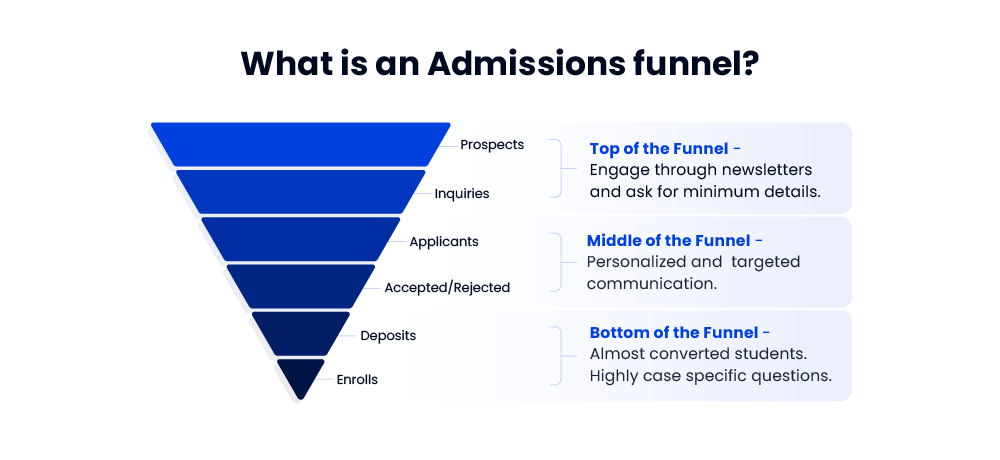
Admission or enrollment funnel is a series of steps that a lead (student) must cross – right from signing up on the website, becoming a prospect, to a hot opportunity to finally becoming a student. The enrollment journey for a student entails various steps like visiting the campus, submitting educational documents, completing the application forms, taking the pre-requisite tests and interviews, and completing the payment to secure a seat. In short, it is a picturized representation of a student’s journey from inquiry to conversion.
Why does the admissions funnel matter in higher education marketing?
As I mentioned before, the student goes through various stages before they decide to enroll for the course.
For higher education marketers, it is important to track this movement to share information and build relevant content.
The funnel also helps in understanding the cues and activities that determine the next course of action for them.
There are three distinct stages of an enrollment funnel – Top, Middle, and Bottom. Based on the student’s interest and interactions, you can determine their stage in the funnel.
Breaking Down the Stages of Admissions Funnel
If you are wondering why we call it a funnel, it is because casual inquiries (top of the funnel) will always be more than the admission-ready inquiries (bottom of the funnel). Let us discuss these stages of the admissions funnel.
Top of the funnel (showing interest in the program or institute)
From a student’s perspective, it is a window-shopping phase. They might be exploring courses, looking for brochures, but are not eligible for or serious about enrollment. But from a counselor’s perspective, this is an opportunity to find students who will graduate soon and may enroll in one of your courses. The aim here is to generate as many leads as possible.
You need only a few fields in your lead capture form. You can nurture inquiries and influence them to take admission in your institution. The purpose of capturing the top-of-the-funnel leads is to build your admissions pipeline. So, keep the lead fields as minimal and precise as possible. But make sure you gather all the relevant information that you’ll need to shortlist a candidate.
Middle of the funnel (visiting the campus, submitting documents)
Here, the students are interested in your institution. It is the right time to connect them with admission counsellors to understand their interests, concerns, etc. You can also send them brochures and invite them to open houses, virtual events, and student communities. You should clearly explain why your institution is the best option. A webinar or a personalized meeting can work wonders.
In terms of leads, they reach this stage either from nurturing activities or directly from ads or your website. However, while capturing the middle-of-the-funnel leads, make sure you get all the relevant information – even if the application form fields are more.
Bottom of the funnel (starting the application form)
These are the most active leads with a high chance of a conversion. Institutions can get away with longer forms at this stage as prospects have made up their mind and are ready to enroll. This is the step when the student has decided to apply for the program.
Before reaching this point, the student journey looks like they have already been through campus tours, understood the opportunities that the college offers, and what kind of a future can they expect in terms of career growth.
For example, the student discovers you through an education fair. They have collected information on the different programs you offer. When your counsellors call them for a campus visit, they already know which courses to pitch. And this personalized engagement, helps the counsellors convert an inquiry to an application.
Therefore, the engagement journey of these leads (student inquiries) will depend on their stage in the admissions funnel.

12 Effective Strategies to Maximize the Admissions Funnel
.
Step 1. Define and create the acquisition process
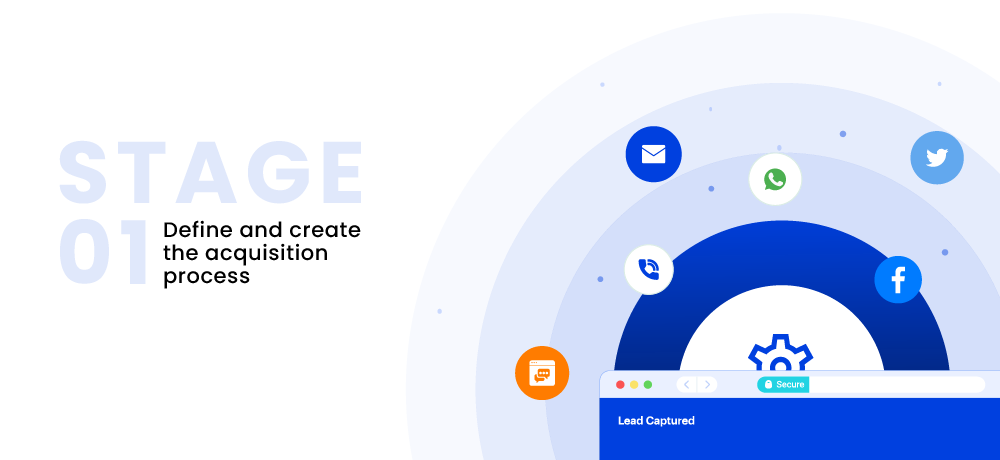
There are various sources through which you can generate student inquiries. However, not missing out on them and assigning them to a student counselor timely is crucial.
Social media channels, such as Instagram, Linked In, Facebook, and various third-party marketplaces or publishers, are the best ways to acquire student inquiries.
Building website landing pages and contact forms on microsites to drive campaign traffic is also effective. With multiple sources to rely on, generating student inquiries might not be that hard. Collating them from different platforms, tracking their status, and following up can be time-consuming. Now the question is – how to manage student inquiries?
Excel to the rescue? Maybe not.
If you are using excel or spreadsheets to maintain this data, you will probably miss out on leads and follow-ups in the process. Hence, the best approach is to use an integrated enrollment solution.
What does an enrollment solution do?
An enrollment platform helps reinvent the admissions funnel – from lead capture to lead management and beyond. It helps counselors identify inquiries that are ready to enroll. With this information, admission representatives can prioritize calling these students and send meeting invitations.
Tips to personalize marketing campaigns
According to marketing insights, the number of global email users will grow to 4.48 billion users by 2024. The numbers confirm that Email and SMS marketing remains one of the most effective ways. However, it is essential to personalize the messages that you send.
The study also reveals that the open rates for emails with personalized subject lines are 50% higher than emails without them. Yet only 2% of emails are personalized.
Next comes your email content. Instead of sending all the information into one email, send a series of at least three personalized emails. A study conducted by Omnisend in 2018 reveals that a series of emails perform better than a single email.
You can also use LeadSquared admissions CRM to capture leads and run a nurturing sequence automatically. With this tool, you can:
1. Nurture leads through personalized email marketing campaigns. Automate emails based on student profiles, interests, and engagement with your campaigns.
2. Choose from a variety of email templates, test their performance, and make changes instantly.
Step 2: Make it easy for counsellor & students to view information
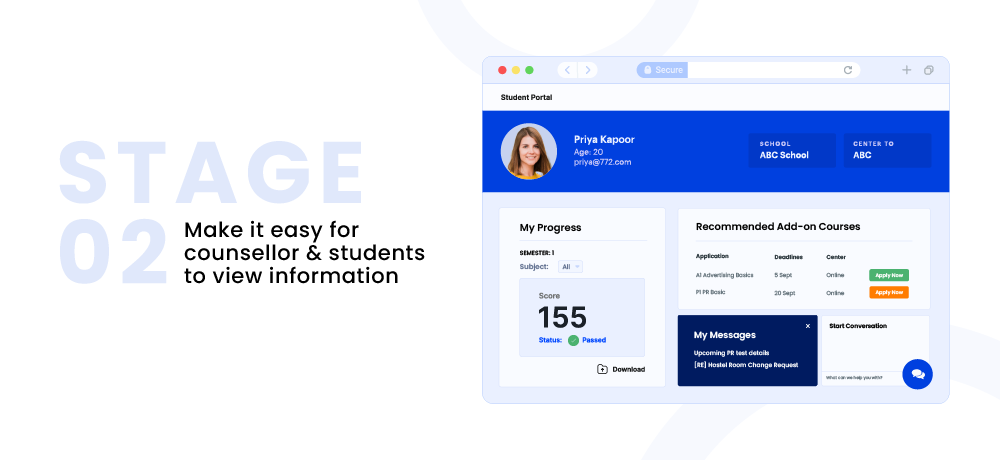
Paperless applicant portals help you make the application journey easy for students. Also, a student-friendly form will always have a higher completion rate. The counselors get to know their audience better when the right field types for admission forms are selected and filled. Admissions-specific workflows help admissions teams focus on incoming inquiries, engage with more leads, and identify their intent in a more organized fashion.
With the help of a student portal, you can:
- Create Responsive Student Application forms – Make it easy for students to manage their profiles, upload documents, and more.
- Speed-up Your Enrollment Process – An automated enrollment system configures applicant details, documents, payment, and e-signature. You can set reminders and alerts for certain tasks for faster processing.
- Collect Signatures and Documents Electronically – With the help of a student portal, students can digitally sign and upload enrollment documents. From a counselor’s perspective, they can access documents online and save countless hours spent in shuffling and document management.
Step 3. Track the progress
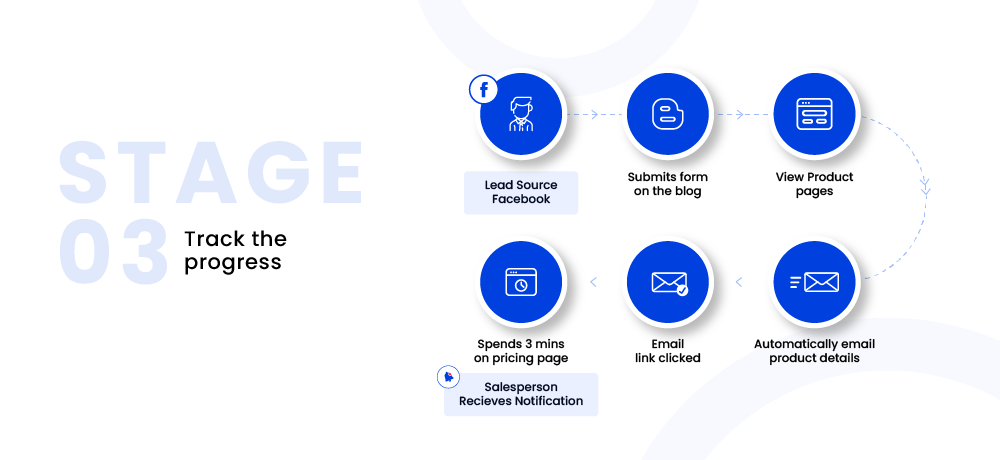
A study by Asend2 suggests that 57% of marketers agree that lead nurturing is the most crucial aspect of closing a customer. Therefore, it is necessary to have the right set of sales and marketing tools at your disposal.
For instance, tools such as admissions CRM provide team members with relevant information regarding courses and curriculum that students would find value in. At the same time, it is also necessary to understand the student’s intent for admission. Again, CRM tools can help capture the intent by tracking the student activities on your website, social media, and ads.
Below are a few points to keep in mind while tracking student activities:
1. Track web activities: Track the student’s intent on your institution’s website through page views, CTA clicks, video views, and more.
2. Track the time spent on the website: Figure out how engaging your content is (and what your students are interested in) by tracking the time spent on each page and analyzing the bounce rate.
3. Track the effectiveness of pages and content: Track link clicks and understand if the content encourages the student to take action.
4. Track sources: Identify if student inquiries are coming from social media, search engines (organic traffic), digital ads, or through publisher websites.
Step 4. Identify process breaks & plug the leaks
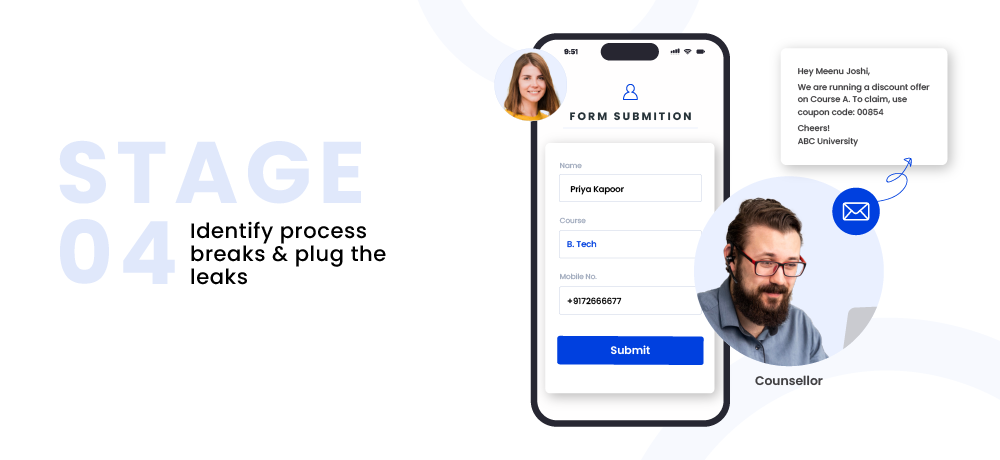
Usually, the college application forms are lengthy. While colleges need this information, students may drop off in the middle for several reasons. Let’s understand this with an example. Vivek, a student, comes across one of your courses on your university website. He starts to fill in the details so that your admission counselors can reach out to him. However, he gets a call from a friend and abandons the form. He might still want to inquire about your institution, but he forgets to do so.
What next?
Did your college lose a student? Not really. Tools like education CRM will capture the exact entry and exit details. So, your counselors will know how to pursue Vivek and understand his intent.
You can also run remarketing campaigns to remind Vivek to complete his application. The best part is – CRM tool lets you initiate and pursue communication through numerous channels, such as emails, texts, calls, WhatsApp, and more. Also, instead of starting again, applicants can pick up from the point they left. All of these will sum up to a better student experience.
Step 5. Send out personalized communication
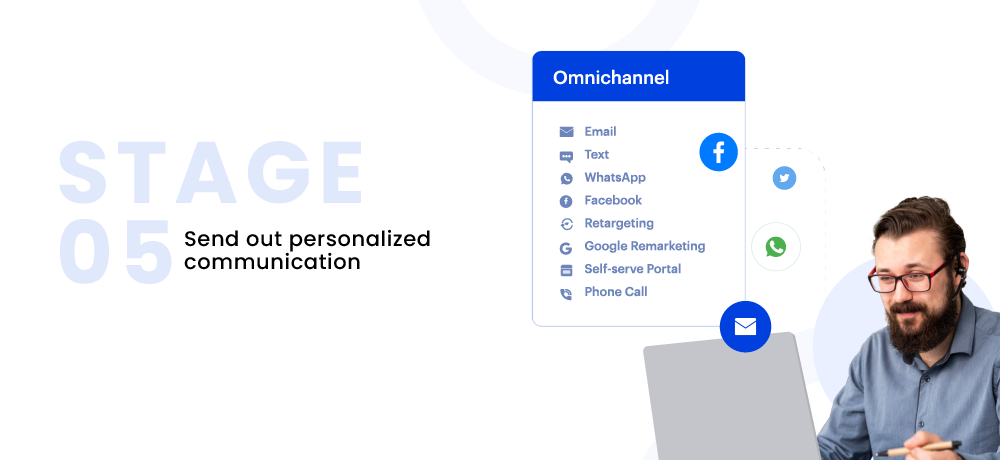
A study by leadsimple reveals that contacting a person within 5 minutes of an inquiry increases the chances of conversion by nine times. However, it is practically impossible to call them immediately.
Solution?
Align marketing and admissions by sending out targeted messages to students/parents who inquire about the courses on your website contact forms/Landing pages.
So how do you ensure a personalized communication with students to keep them engaged?
No matter how or when a student fills out a form, the enrollment system creates a curated touchpoint. It helps engage with the student till a counselor reaches out to them.
Step 6. Build transparent processes through automation
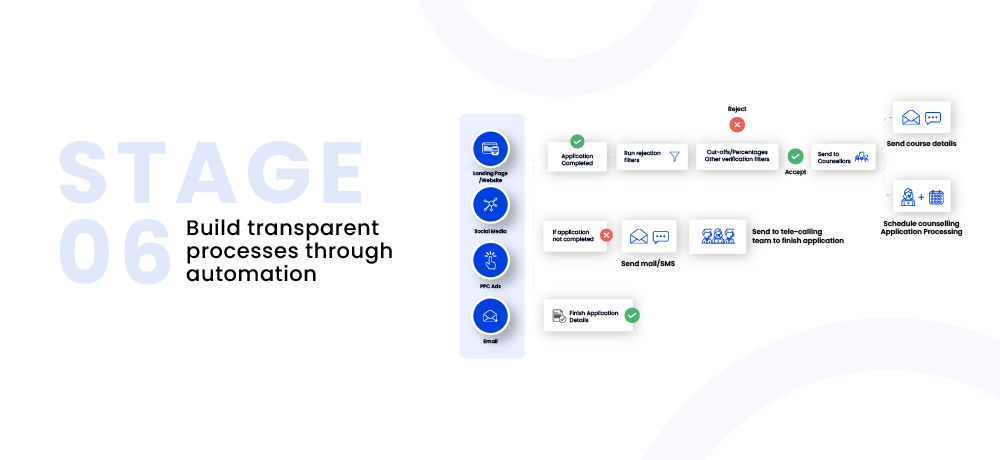
With the help of a workflow builder, you can keep all the teams informed and connected. One can automate actions at different steps in the student journey. (For instance, if the student doesn’t finish the application form, the counselor gets notified). Once the application is complete, it is automatically sent to the verification team. Accepting or rejecting an application can be based on several automated or manual criteria.
Step 7. Assign the right counsellors & avoid duplicate entries
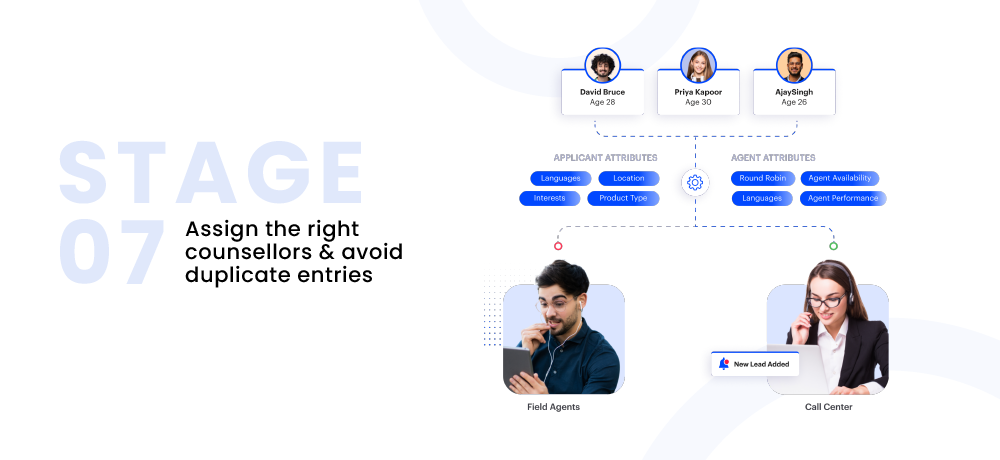
Duplicate leads are a concern for most educational organizations. For example, when a student inquires about your courses on your website and social media, it might create a duplicate record in your system. Such duplicate entries decreases the productivity as different counselors may spend time pursuing the same lead. But a deduplication logic in place ensures the counselors work only on unique leads. From a prospect’s perspective, deduplication improves their experience by reducing the chances of redundant communication.
Admissions CRM makes it easy to filter duplicate leads. Instead of creating new records, it updates the existing record with lead activities. After filtering the data, the system automatically assigns the lead to the counselors for follow-up. This distribution can be done based on specific lead or counselor attributes – unique to an institution.
If the counselor is unavailable or there is a delay in reaching out to the prospect, the CRM system assigns the lead to the next available counselor. The system also solves the problem of overloading your counselors with leads at any given point in time. With a capping logic, the system assigns an appropriate number of inquiries and distributes them equally among the team.
Step 8. Prioritize whom to call first
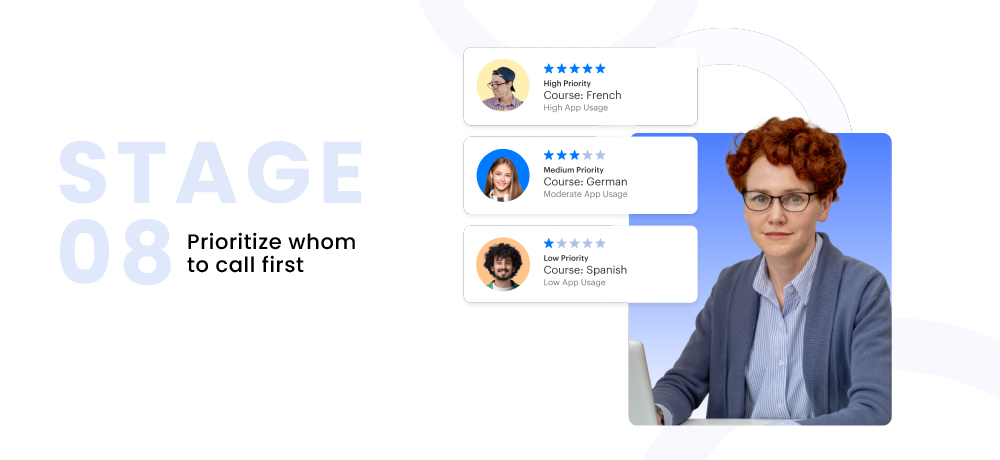
Admission counselors and call center agents struggle with figuring out whom to reach out to first. So, how to prioritize student inquiries that have a higher chance of conversion?
In high-velocity operations, like that of educational institutions, 100s of admission inquiries flood in daily. It is impossible to call every lead – resulting in missing out on follow-ups and recruitment opportunities.
So what should you do?
Prioritizing leads based on a scoring system can help you in this case. Lead scoring plays a vital role in prioritizing and selecting admission-ready students. You can assign scores based on the student’s involvement in your offerings, student attributes, and activities.
When a student frequently checks your emails, spends time on your website, or interacts with your content, it means that they have a higher chance of a conversion. Parallelly, the stage of the student in the admissions funnel changes. Tools like admissions CRM help you automatically segment inquiries into different buckets like inquiries, applications, eligible/opportunities, and more. This list can also help you prioritize follow-ups. For example, you would want to talk to eligible candidates first. Prioritization and segmentation also help counselors better assist the student and move them forward in the admission cycle.
Step 9. Build efficient calling processes
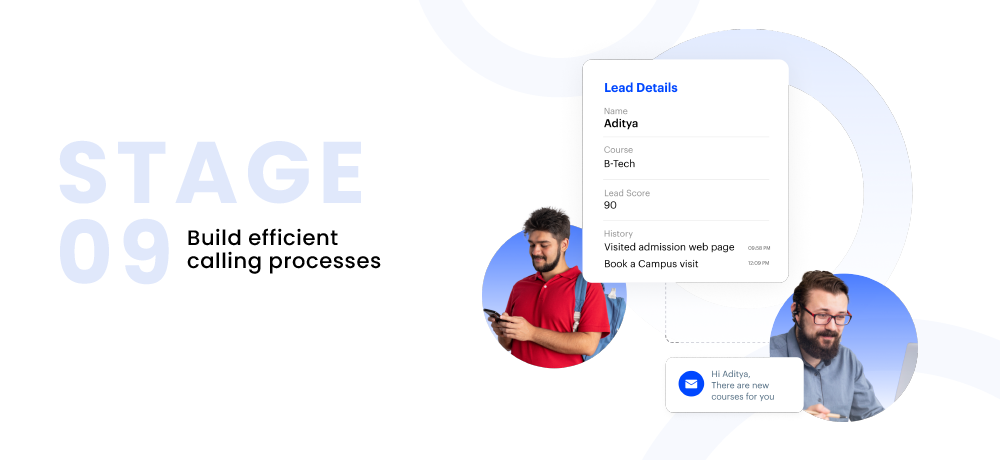
In the education industry, the lead volume is usually high, the channels are many, and a large percentage of students don’t finish their application forms online. It isn’t easy to ensure that all students are reached out on time. Hence, a call center system ensures that you don’t miss out on any opportunities.
A study by Microsoft reveals that 56% of consumers have stopped doing business with a brand due to a poor customer service experience. Out of that, 47% of consumers moved to the competitor. It indicates that colleges should take care of all calls and resolve student inquiries without delay.
Step 10. Boost counsellor efficiency with the right tools
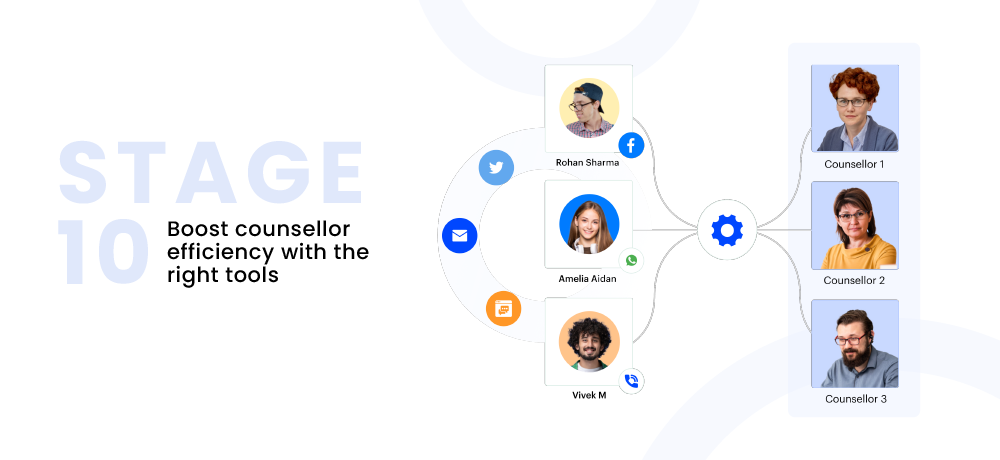
Most educational institutions use an integrated CRM with a contact center solution or an IVR to never miss out on leads. It provides your program associates/counselors a 360-degree view of students and their requirements. It helps them deliver a personalized service.
Instead of purchasing a separate call center suite and CRM suite, implementing an education CRM that comes with a call center integration is the best choice for educational organizations. Progressive/predictive dialing features of CRM will allow you to call high-priority prospects automatically.
Step 11. Build student journey maps by tracking student activities
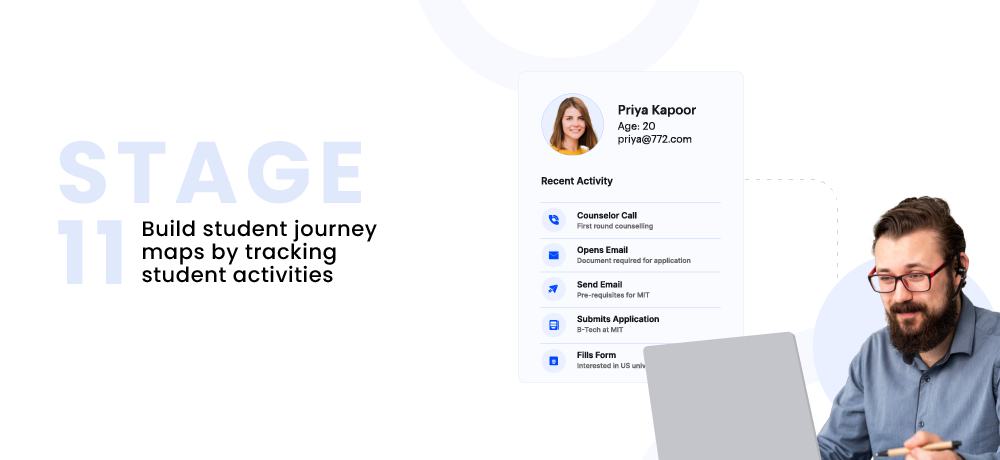
Once the student inquiries get distributed among counselors, they can see student details in one place. It also gets easier to identify their position in the admissions funnel. They can see all assigned leads, opportunities, activities, tasks, and other details through a single dashboard. The activities overview will help you map the student journey – from inquiry capture to enrollment.
For instance, in LeadSquared Admissions CRM, you can set up the following views: Application completed for MBA, Engineering, Arts, and other courses that you offer. You might add different buckets such as new leads added, leads assigned to do, lead overdue, progress to do, or other filters.
Benefits of using Admissions CRM –
- It gives counselors a single work area for accessing lead details, opportunities, activities, and tasks.
- Provides a better alternative to filters – you can see your saved filters as tabs.
- Shows you the leads count on each tab.
- Automatically refreshes so your tabs are always updated.
- You can also receive daily reports for the views you create.
Driving conversions is a tedious task and requires support from seniors and experts. Therefore, managers should be able to see the team’s activities and take appropriate actions.
To give you an example, an important aspect of enrollment process is follow-ups with prospective students. The chances of reaching a lead are 100 times higher if they are called within 5 minutes. However, with the sheer volume of inquiries that educational institutes receive, missing out on follow-ups is common.
But what if you could track the daily operations for your teams, such as calls made, emails sent, and follow-ups missed, and intervene when necessary?
With the help of analytics, managers can have complete visibility and transparency about the daily activities of student counselors and their overdue, completed, and upcoming tasks. If a counselor has not worked on an inquiry for a long time, the CRM tool will escalate and route the lead to another counselor automatically. It ensures a seamless admission process.
The following are some of the essential metrics that you can track on CRM:
1. Emails sent by counselors and their click and open rates.
2. Call volume, connect rate, and successful conversation numbers.
3. Call recordings and email audits
4. The number of students in each stage of the admission pipeline
5. Meeting schedule of your field sales team on a daily, weekly, or monthly basis.
6. The admissions your counselors close or commit to the admission pipeline.
7. The revenue contributed vs. the activities of the counselors.
8. Missed tasks and activities.
Step 12. Measure performance and efficiency regularly
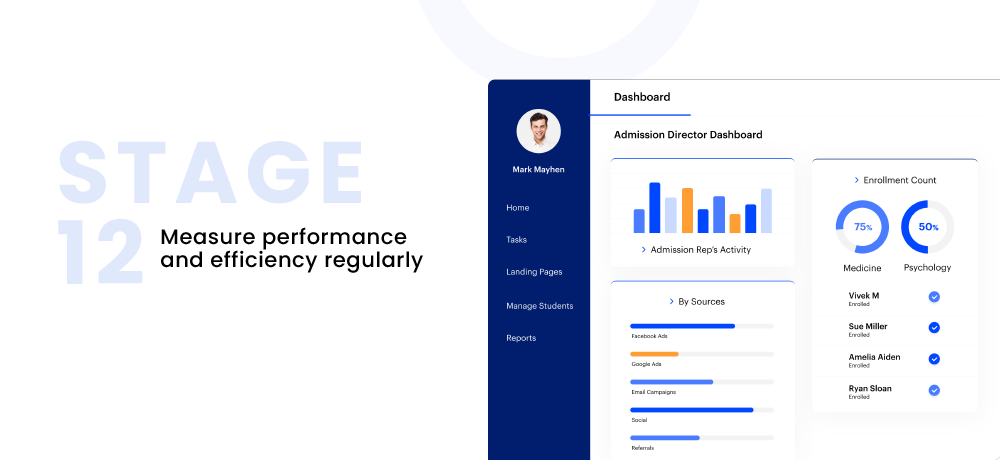
A detailed analysis of ongoing business activities in a decision-ready format is necessary to streamline admissions. Performance metrics on sources, campaigns, admissions teams (online and offline teams), counselors, call center agents, and more should be revisited in a timely format.
With reliable Analytics, you can redefine your strategies and invest more in profitable sources. Thus, payment milestone reports, phone call metrics, student admission stage transition analysis, and complete reporting for all your processes, teams, courses, and campaigns can help boost admissions.
“It is necessary to track metrics while enabling a virtual ecosystem. Telecalling, counselling, campus tours, staff interaction should be available to students and parents, hence technology is extremely important at this stage. Institutions should concentrate on their core areas such as placements and academics. Admission is just a phase but reaching there requires several pre-requisites which need to be emphasized. The number of inquiries, admission forms, virtual and physical campus visits needs to be tracked. People are more informed now and shifting to a digital model has been effective as it provides a detailed outlook on ROIs.”
Rahul Singhi, Director & Co-Founder, Poornima University.
Education institutions should track the following KPIs:
- Overall performance of lead generation sources, admission counselors, teams, and marketing campaigns
- Team performance
- Product (subjects, courses) performance
- Campaign source performance
- Agents performance
- Return on Advertisements (ROAs)
Wrapping Up
Managing student admissions has its own twists and turns. It requires attention to detail, identifying why students drop-off, and understanding whether our communication is working or not.
With the help of an enrollment CRM, educational institutions can manage and test the best strategies in the student enrollment process. Gaining visibility into the admissions funnel makes it easier to push inquiries to enrollments faster.
Ensure quicker student conversions with LeadSquared’s end-to-end enrollment CRM backing your admissions team.
FAQs
Schools can improve their admissions funnel system by dividing and tracking students in various stages—top, middle, and bottom of the funnel. This will allow them to build personalized conversations at scale and improve enrollment rates.
Choosing the right course and school for a student is stressful enough. With counsellors sharing information catered personally to them, it is one less answer they need to hunt for. Using automation and activity-tracking, counsellors can increase the chances of the student moving to the next stage by triggering personalized messages across multiple mediums.
Read further:









